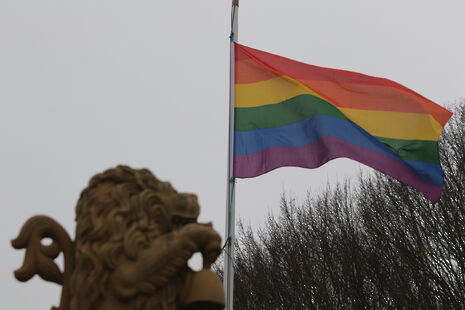Biphobia isn’t just an idea. It is killing people
Joel Lucyszyn addresses the disproportionate levels of life-threatening behaviour in bisexual people and challenges their causes

CN warning: discussion of sexual assault, mental illness, suicide and drug use.
In this last column, I want to talk about the very real intersection between biphobia and life-threatening behaviour. Throughout the column series, I’ve sought to trace a few of the main biphobic misconceptions from their origins to their current impact on bisexual people. These different factors all contribute to the pressures bisexual people have to face every day, with two main statistical horrors standing out in particular: the levels of sexual violence faced by bisexual women, and the associated rates of mental illness, substance abuse and suicide experienced by bisexual people.
The National Intimate Partner and Sexual Violence survey of 2016 reported that nearly half of the bi women they interviewed had been raped during their lifetime. On average, bisexual women were 32% more likely to have been a victim of sexual assault than straight women, and 29% more likely than lesbian women. The disproportionate levels of sexual violence experienced by bisexual women is further confounded by emerging research which demonstrates bisexual women face greater negative consequences from sexual assault, including lack of effective support networks in the LGBT+ community.
“Bi people suffer from severe mental health issues more than any other sexual orientation”
It isn’t difficult to relate these findings to another startling and underrepresented fact about mental illness in the queer community. I’ve attended many events in Cambridge which have poignantly and productively addressed mental illness crises in the queer community, yet to this day, have never heard one person address the overwhelming intersection between bisexuality and mental health. Bi people suffer from severe mental health issues more than any other sexual orientation: including anxiety, depression and suicide. In conjunction - and inevitably related - there are significantly higher rates of substance abuse in bisexual people, specifically young bisexual men.
When we have studies showing us time and time again that rates of sexual violence, mental illness, and suicidality are significantly higher for bisexual people, why are people still so silent? Precisely because of the same reasons we see such damning results: systematic biphobia. Dr Nicole Johnson has linked the high rates of sexual violence experienced by bisexual women with the hypersexualisation of bisexual women, biphobic harassment and the abuse of drugs and alcohol. Bisexual women are often fetishised, particularly by straight men, who denigrate female bisexuality as a hypersexual act for the male gaze. This plays into narratives about ‘performative bisexuality’, where bisexual women are seen as performing their sexuality for men – this leads to other nasty attitudes, such as victim-blaming, as people often see bisexuality as an orientation implicitly trying to gain male attention. For these reasons in particular, and for the many and various biphobic strains of thought I’ve looked at throughout the column series, the threat of violence against bisexual women is far higher than for lesbian or straight women.
The intersection between sexual violence, mental illness and drug abuse is obvious. In a world where studies estimate only 12% of bisexual men are out in public in the US due to threats of violence and rejection by queer and straight people, and bisexual women have their identity consistently belittled, erased and hypersexualised, the weight placed on bisexual individuals is severe and damaging. These patterns of thought live and breed in biphobic comments – even in an ill-timed and ignorant joke – so there is a need, more than ever, to recognise how encouraging a culture of biphobia poses a very real threat on the mental health and bodies of bisexual people; as Dr Johnson has commented: "Sexual violence enacted against bisexual women within intimate relationships may result from social constructions of bisexual women as especially worthy of distrust, jealousy, and other emotions and/or perceptions related to uneven power dynamics and hostility within the relationship."
The concrete threats biphobia poses can include worsening mental illness, erasure and isolation, sexual violence and suicide. The statistics quoted are demonstrative of an epidemic occurring within the queer community, one which is overlooked and purposely swept under the carpet. The positive and vital work of academics and researchers has revealed to us more than ever the need to challenge biphobia in its many manifestations, but far much more work needs to be done, including the critique of biphobic institutions which suppress bisexual scholars and activists. Bisexuality has always been here, and it has always flourished, but it has always been denigrated and erased. The paradoxical threat faced by bisexual people – to be erased, made invisible, while also targets of explicit sexual violence and harassment – is a nasty, life-damaging blend of prejudice. If this column series has contributed even one spec to the effort to challenge biphobia, it has been worth it
 Comment / Plastic pubs: the problem with Cambridge alehouses 5 January 2026
Comment / Plastic pubs: the problem with Cambridge alehouses 5 January 2026 News / Cambridge businesses concerned infrastructure delays will hurt growth5 January 2026
News / Cambridge businesses concerned infrastructure delays will hurt growth5 January 2026 News / New movement ‘Cambridge is Chopped’ launched to fight against hate crime7 January 2026
News / New movement ‘Cambridge is Chopped’ launched to fight against hate crime7 January 2026 News / Uni-linked firms rank among Cambridgeshire’s largest7 January 2026
News / Uni-linked firms rank among Cambridgeshire’s largest7 January 2026 News / AstraZeneca sues for £32 million over faulty construction at Cambridge Campus31 December 2025
News / AstraZeneca sues for £32 million over faulty construction at Cambridge Campus31 December 2025








